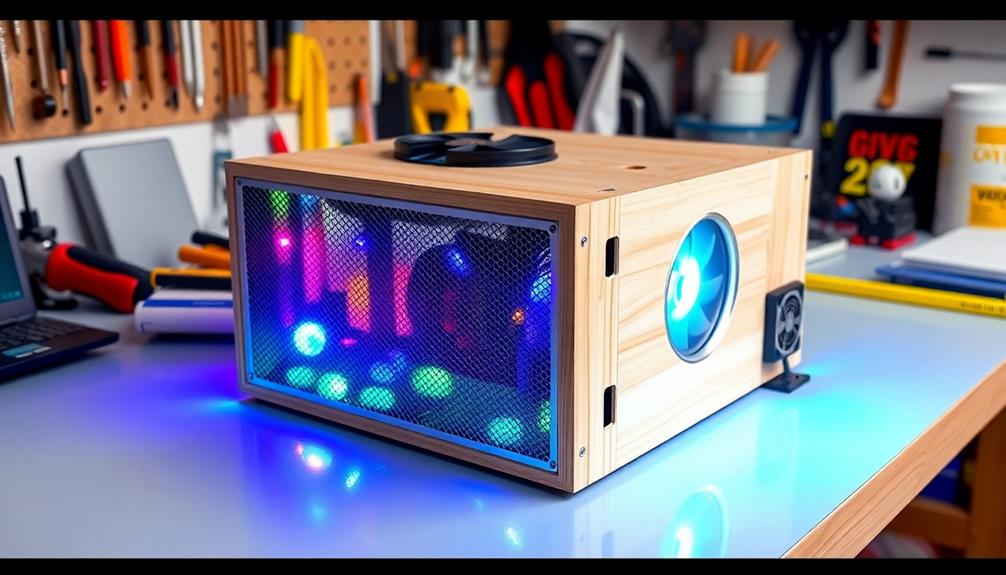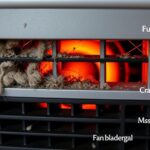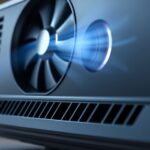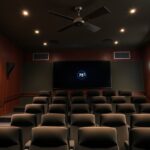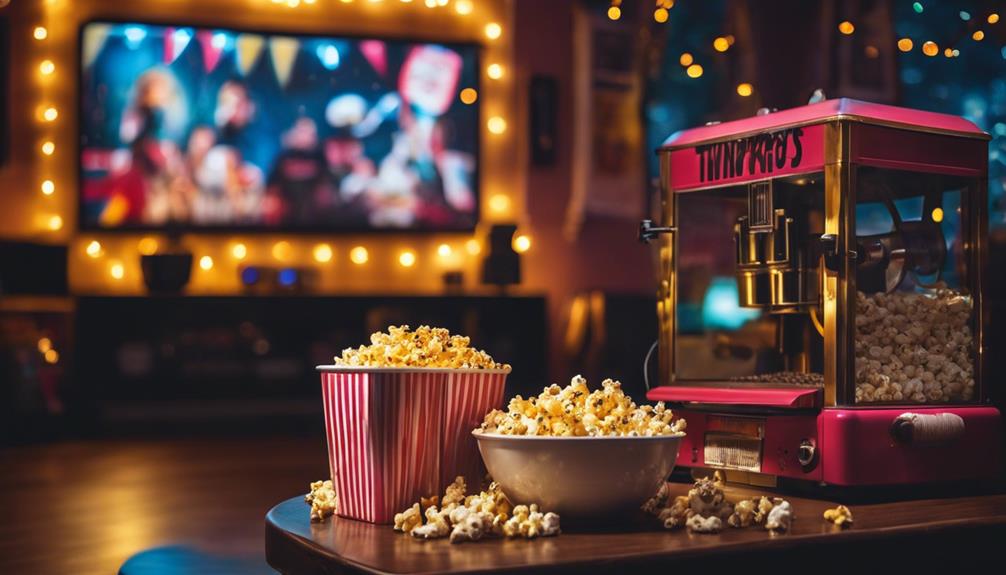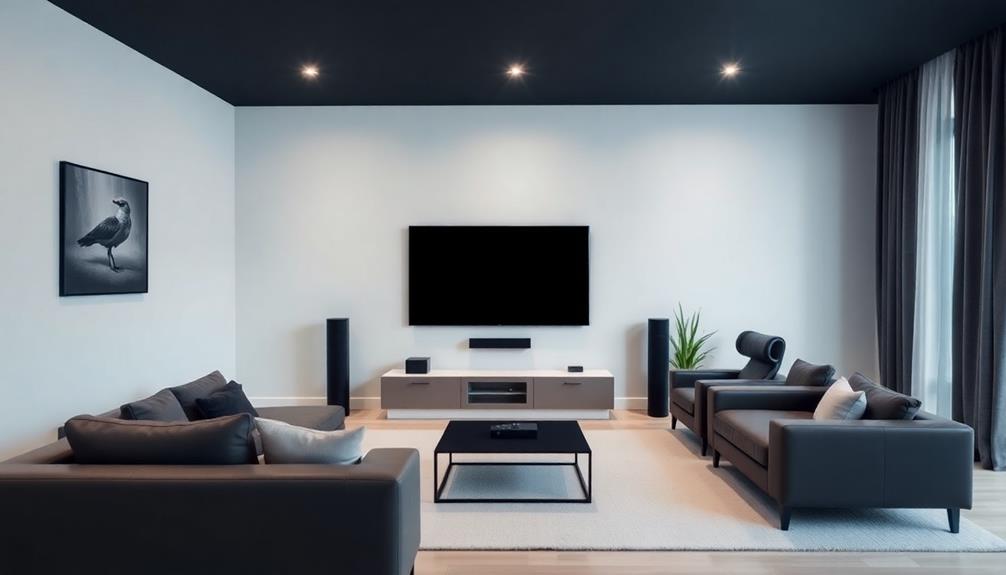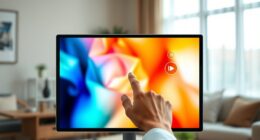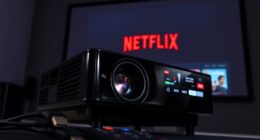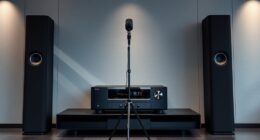To boost your projector's performance, a DIY cooling pad is a practical solution. Start by designing a pad that's about 10 inches long and 1 foot wide, incorporating two USB-powered fans for maximum airflow. Place one fan to blow air toward the projector's intake and another to exhaust hot air away. Don't forget to add dust filters to keep the air clean. Monitor the internal temperature to verify it stays below 95°F. Regular maintenance, like cleaning fan filters, will improve airflow. If you want to explore more tips and ideas, there's plenty of information awaiting your discovery.
Key Takeaways
- Design a cooling pad with dimensions around 10 inches long and 1 foot wide for optimal airflow around the projector.
- Incorporate at least two USB-powered fans: one for intake and another for exhaust to enhance cooling efficiency.
- Regularly clean dust filters on fans and ventilation openings to maintain airflow and prevent overheating.
- Monitor internal temperatures with digital thermometers, ensuring they remain below 95°F during operation.
- Explore cost-effective solutions like household fans and DIY heat sinks to improve heat dissipation and airflow.
Importance of Cooling for Projectors
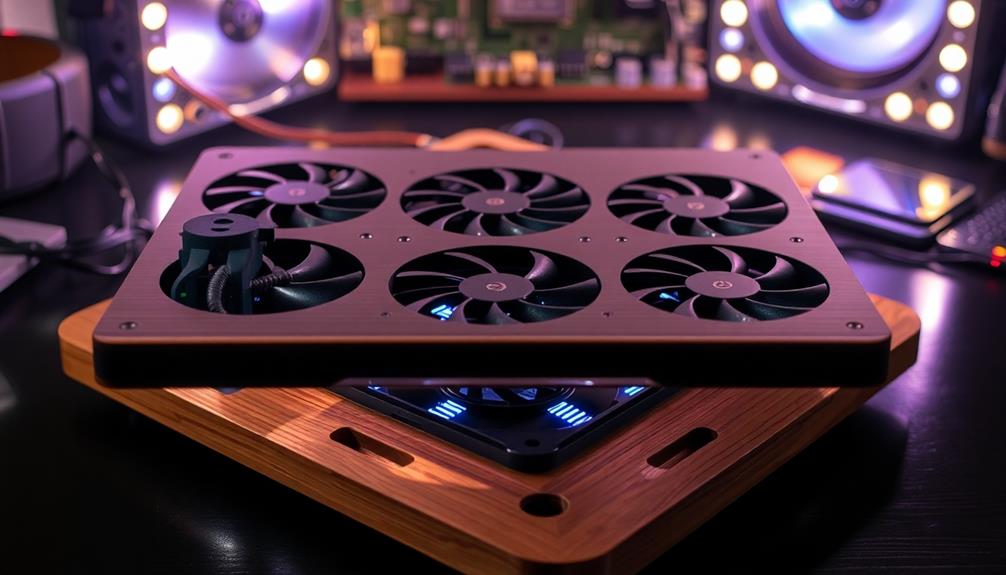
Cooling is essential for the best performance of projectors. When you use a projector, it generates substantial heat, causing internal temperatures to rise from an initial 60°F to 81-82°F after just 2.5 hours. If this heat isn't managed properly, you could face performance issues. Excessive heat can damage crucial components, like polarizer plates in LCD models.
That's why effective cooling solutions are important for extending your projector's lifespan and maintaining its functionality.
You need to pay attention to temperature limits as well. For projectors operating below 7500 feet, the maximum allowable temperature is 95°F, while it drops to 86°F for those at higher altitudes. This makes temperature regulation critical.
Active cooling methods, like USB-powered fans to increase airflow, are essential for preventing overheating and ensuring best performance during extended use.
Regularly monitoring internal and exhaust temperatures, along with maintaining proper ventilation, helps you avoid heat-related problems that can lead to costly repairs and disruptions.
Designing Your Cooling Pad

To keep your projector running smoothly, designing an effective DIY cooling pad is key. Start by ensuring your cooling pad accommodates the projector's dimensions, ideally around 10 inches long and 1 foot wide. This design should allow for maximum air flow and temperature regulation.
Here are some essential components to take into account:
- USB-powered fans: Use at least two fans—one to blow cooler air toward the projector intake and another to exhaust hot air from the housing.
- Dust filters: Add filters to the fan inlets to keep dust and debris out, ensuring clean air flow over time.
- Temperature monitoring: Aim to keep the internal temperature below 95°F (35°C) during operation. A digital thermometer with multiple sensors can help track internal and exhaust temperatures for effectiveness.
- Space for ventilation: Design the pad with enough space around the projector to allow for unrestricted air flow, preventing overheating.
Fan and Ventilation Placement

When setting up your DIY projector cooling pad, proper fan and ventilation placement is vital for maintaining ideal temperatures. Start by positioning one fan to blow air toward the projector's intake, while another fan will push hot air away from the projector. This setup guarantees efficient heat dissipation and keeps your projector running smoothly.
Next, consider installing two air vents on opposite sides of the projector box. This enhances natural airflow and reduces the risk of overheating during operation. You might also add a third USB-powered fan at an angle to improve circulation and prevent hot air from stagnating around the projector.
Make certain all fans are aligned with the projector's airflow path. Misalignment can create counterproductive airflow that hinders cooling efficiency. Finally, don't forget to regularly clean fan filters. This maintenance step is vital for preserving airflow effectiveness and protecting your projector's internal components from dust and debris.
| Fan Placement | Function |
|---|---|
| Intake Fan | Pulls cool air in |
| Exhaust Fan | Pushes hot air out |
| Additional USB Fan | Enhances circulation |
Temperature Monitoring Techniques

To keep your projector running smoothly, you'll want to monitor temperatures closely.
Start by placing digital thermometers in key areas to get accurate readings and regularly check ambient conditions.
Documenting these readings over time helps you spot trends and make necessary adjustments to your cooling setup.
Digital Thermometer Placement
Effective temperature monitoring is essential for maintaining your projector's performance, and placing your digital thermometer correctly can make all the difference.
To achieve accurate results, here are a few tips on where to position your thermometers:
- Near the exhaust vent: Place one digital thermometer close to the projector's exhaust vent to measure the warm air being expelled.
- Inside the housing: Consider positioning a second thermometer inside the projector housing to monitor internal temperatures directly.
- Calibration: Confirm both thermometers are calibrated and provide precise readings to avoid inaccurate data that could affect your cooling strategy.
- Document readings: Regularly document temperature readings over time to identify patterns, allowing you to make informed adjustments to your cooling setup as needed.
Monitoring Ambient Conditions
Monitoring ambient conditions is essential for your projector's performance, especially during extended use. To effectively keep track of your projector's internal environment, using digital thermometers is highly recommended. These devices provide accurate temperature readings inside the projector housing, allowing you to monitor ambient conditions and guarantee safe operation.
Strategically placing these thermometers within the projector setup is critical. By identifying hotspots where air movement is minimal, you can take steps for improving airflow and enhancing projector cooling. Regularly checking and adjusting based on these temperature readings helps maintain ideal performance.
If you're using your projector outdoors, pay close attention to ambient temperature fluctuations. It's important to confirm the internal temperature remains within safe limits, preventing overheating.
Additionally, monitoring both the internal and exhaust temperatures gives you insights into cooling effectiveness.
Documenting Temperature Readings
Documenting temperature readings is essential for maintaining your projector's performance and preventing overheating. By tracking these readings, you can confirm that your cooling pad is working effectively and that your projector operates within safe temperature limits.
Here are some key techniques for monitoring temperature:
- Use digital thermometers for accurate temperature readings inside the projector housing.
- Document temperature readings at regular intervals during operation to assess cooling effectiveness.
- Monitor the temperature after 2.5 hours of use; it may rise to 81-82°F, which you should compare with the maximum allowable temperature of 95°F for projectors below 7500 feet.
- Maintain a log of ambient and exhaust temperatures to evaluate your cooling system's overall performance.
Regularly check for significant temperature fluctuations, correlating them with environmental conditions like humidity and external temperatures.
This proactive approach allows you to make necessary adjustments, confirming ideal projector operation. By diligently documenting temperature readings, you'll not only enhance your projector's lifespan but also enjoy uninterrupted viewing experiences.
Altitude Effects on Performance
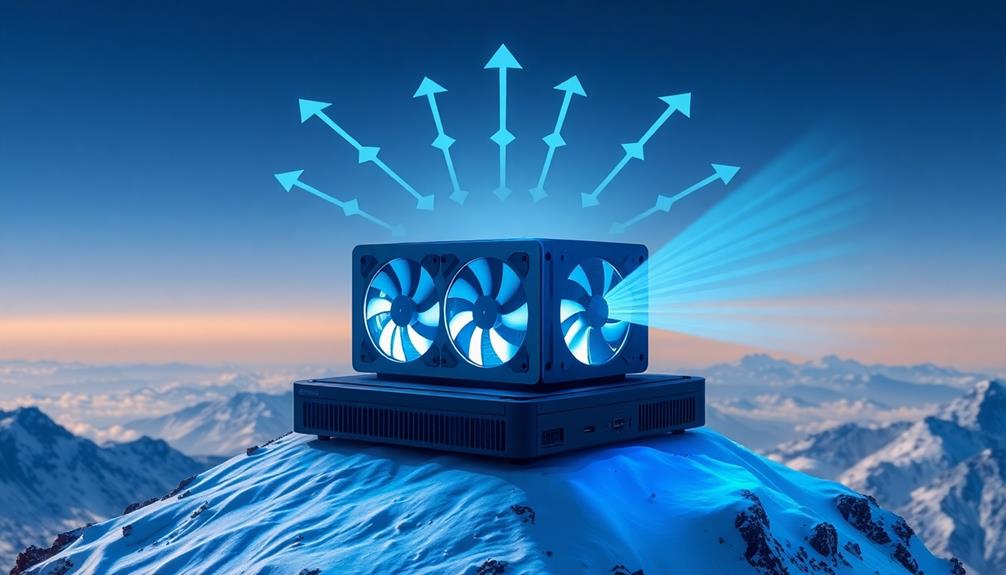
Altitude can greatly impact your projector's performance, especially when it comes to cooling efficiency. If you're using your projector below 7,500 feet, keep in mind that the maximum operating temperature is set at 95°F (35°C).
However, once you're above this elevation, that limit drops to 86°F. This reduction in air density at higher altitudes can hinder effective cooling, making your projector more prone to overheating if ventilation isn't up to par.
To combat this, make sure your cooling systems are designed to handle the thinner air. The performance of cooling fans may diminish, so you'll need a reliable strategy to maintain airflow.
Monitoring ambient temperatures within your projector housing is vital, particularly at high altitudes where temperature fluctuations can be more pronounced.
Accurate elevation measurements will help guide your cooling strategies, allowing you to adjust as needed to protect your projector.
Testing and Maintenance Protocols
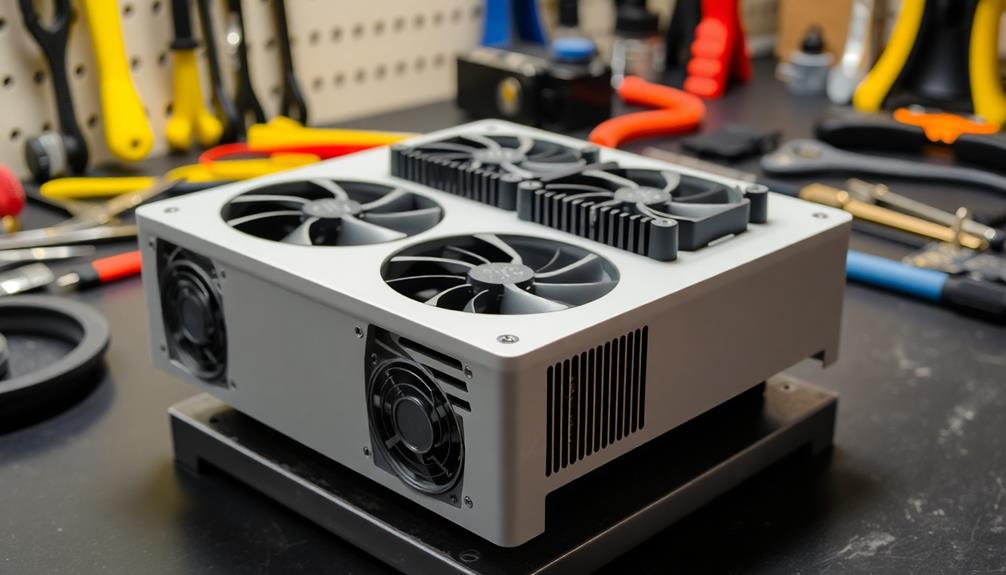
To keep your DIY projector cooling pad in top shape, regularly monitor the internal temperature using a digital thermometer.
Make sure to clean fan filters and ventilation openings to prevent dust buildup that can restrict airflow.
Adjust your cooling strategies based on temperature readings to maintain peak performance during use.
Regular Temperature Monitoring
Keeping a close eye on the internal temperature of your projector housing during operation is essential for maintaining ideal performance. Initial readings indicated temperatures rising from 60°F to 81-82°F after just 2.5 hours of use.
To guarantee your projector runs smoothly, follow these monitoring protocols:
- Utilize digital thermometers: Place them strategically to gather accurate temperature data about airflow effectiveness. Regular maintenance, similar to air purifier maintenance dos and don'ts, can enhance the overall performance of your setup.
- Document fluctuations: Keep track of temperature changes and exhaust temperatures to assess cooling efficiency and adjust your fan and ventilation setup as needed.
- Monitor ambient conditions: Be aware of the humidity and temperature around your projector box, as these factors can influence your projector's performance and longevity.
- Check power supply: Confirm the power supply is stable and functioning properly, as fluctuations can lead to increased heat generation.
Cleaning Fan Filters
Maintaining ideal airflow is essential for your projector's performance, and cleaning the fan filters plays a considerable role in this process. You should check and clean the filters at least once a month, or more often if you're in a dusty environment. This regular maintenance keeps airflow efficient and prevents overheating.
To clean fan filters, use a soft brush or compressed air to gently remove dust and debris. Be careful not to push particles deeper into the ventilation system. If your filters are washable, clean them with mild soap and water, ensuring they dry completely before reinstalling them. Moisture inside the projector can lead to issues.
After cleaning, monitor the exhaust temperature and your projector's general performance. This helps you assess the effectiveness of airflow and cooling. Keep a log of your cleaning schedule and any changes in temperature readings.
Over time, this documentation will help you establish a maintenance routine that enhances your projector's performance. By regularly cleaning fan filters, you contribute considerably to your projector's longevity and efficiency.
Airflow Adjustment Strategies
Here are some key steps to maintain ideal airflow:
- Check temperatures: Verify the internal temperature stays below 95°F (35°C) at elevations below 7500 feet, or 86°F above that altitude.
- Test fan placements: After setup, document temperature changes to see if your fan placements effectively keep exhaust temperatures below 110°F.
Utilizing a well-designed cooling system can enhance overall performance and longevity of your equipment, similar to how air purifiers improve indoor air quality.
- Clean filters: Routinely clean fan filters to prevent dust buildup, which can obstruct airflow and reduce cooling efficiency.
- Adjust configurations: If overheating persists, consider adding more fans or modifying their placements based on temperature readings.
Community Insights and Experiences
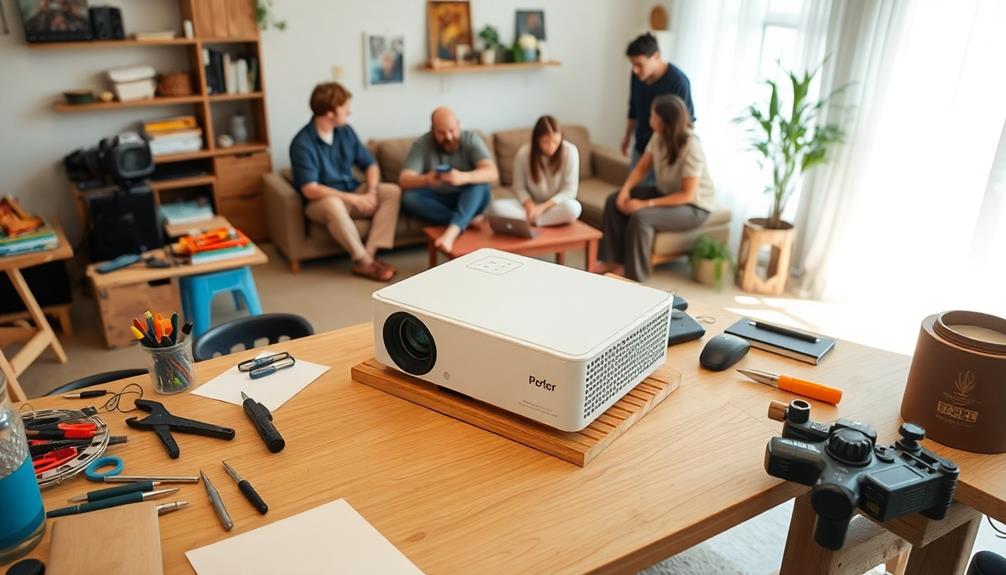
In the DIY community, many enthusiasts have found effective ways to cool their projectors during extended use. One popular method involves adding USB-powered fans near projectors to help push hot air away. These fans enhance airflow and considerably reduce the risk of overheating.
Understanding the importance of safety gear can also be essential when working on DIY projects, ensuring that all modifications are performed with caution. You'll often find detailed discussions on forums where members share tailored solutions based on specific projector models, which can help you optimize your cooling strategy.
Balancing noise reduction with effective heat management is a common theme in these conversations. Users frequently experiment with different fan placements and airflow designs, discovering that small adjustments can lead to noticeable improvements in cooling efficiency.
For instance, placing larger, quieter fans can maintain performance without adding distracting noise. Additionally, some community members explore alternative cooling solutions, like passive mechanisms, which can complement active cooling strategies.
Cost-Effective Cooling Solutions
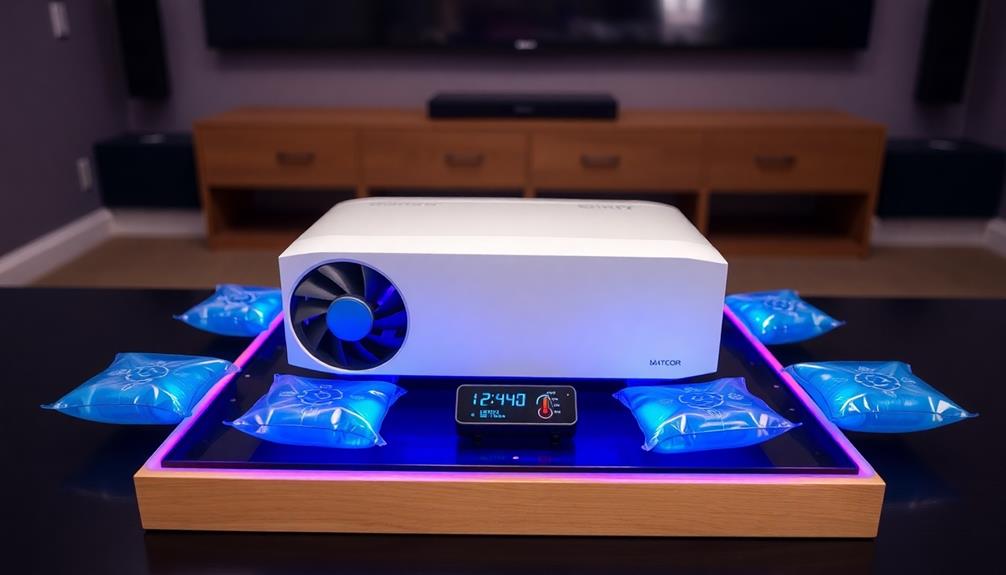
A variety of cost-effective cooling solutions can keep your projector running smoothly without breaking the bank. You don't need to spend a fortune on commercial cooling systems; simple DIY strategies can make a significant difference.
Here are some effective methods to evaluate:
- Household Fans: Utilize strategically placed fans to enhance airflow around your projector, ensuring it stays cool.
- DIY Heat Sinks: Create heat sinks from materials like aluminum to improve heat dissipation, providing a practical alternative to store-bought options.
- Ventilation Improvements: Cut additional openings in projector enclosures to promote better airflow, addressing heat issues with minimal effort.
- Regular Maintenance: Keep filters and vents clean to prevent dust buildup, which helps maintain the efficiency of your cost-effective cooling solutions.
Frequently Asked Questions
How Can I Improve the Cooling of My Projector?
To improve your projector's cooling, position USB fans strategically, monitor temperature levels, clean filters regularly, and consider adding a third fan if needed. Explore quieter fans to minimize noise while ensuring ideal airflow and performance.
How to Reduce Fan Noise of Projector?
To silence the projector's roar, swap out that small fan for a larger, quieter one. Clear any barriers around it, and consider adding passive cooling like heatsinks to whisper sweet relief into your viewing experience.
Do Projectors Have Cooling Fans?
Yes, projectors have cooling fans to manage heat during operation. These fans draw in cool air and expel hot air, ensuring your projector runs smoothly. If needed, you can enhance cooling with additional solutions.
Conclusion
So, you've built the perfect DIY projector cooling pad, right? Ironically, while you're busy improving airflow and performance, don't forget that a cooler projector might just lead to longer movie marathons! Who knew a little extra airflow could turn your cozy nights into epic viewing sessions? Just remember, with all that heat management, your projector's newfound efficiency might leave you questioning whether it's really the film or the temperature that keeps you glued to the screen.
